The fine-scale genetic structure of the British population
- PMID: 25788095
- PMCID: PMC4632200
- DOI: 10.1038/nature14230
The fine-scale genetic structure of the British population
Abstract
Fine-scale genetic variation between human populations is interesting as a signature of historical demographic events and because of its potential for confounding disease studies. We use haplotype-based statistical methods to analyse genome-wide single nucleotide polymorphism (SNP) data from a carefully chosen geographically diverse sample of 2,039 individuals from the United Kingdom. This reveals a rich and detailed pattern of genetic differentiation with remarkable concordance between genetic clusters and geography. The regional genetic differentiation and differing patterns of shared ancestry with 6,209 individuals from across Europe carry clear signals of historical demographic events. We estimate the genetic contribution to southeastern England from Anglo-Saxon migrations to be under half, and identify the regions not carrying genetic material from these migrations. We suggest significant pre-Roman but post-Mesolithic movement into southeastern England from continental Europe, and show that in non-Saxon parts of the United Kingdom, there exist genetically differentiated subgroups rather than a general 'Celtic' population.
Figures
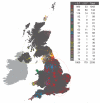
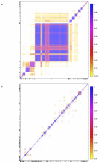
























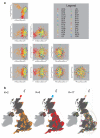
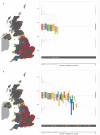
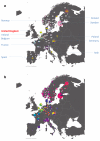
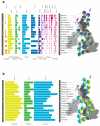
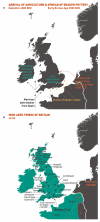

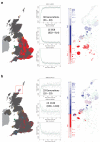
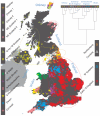

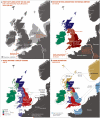
Comment in
-
Population genetics. The peopling of Britain.Nat Rev Genet. 2015 May;16(5):256-7. doi: 10.1038/nrg3938. Epub 2015 Mar 31. Nat Rev Genet. 2015. PMID: 25824870 No abstract available.
References
-
- Cardon LR, Bell JI. Association study designs for complex diseases. Nat. Rev. Genet. 2001;2:91–99. - PubMed
-
- Marchini J, Cardon LR, Phillips MS, Donnelly P. The effects of human population structure on large genetic association studies. Nat. Genet. 2004;36:512–517. - PubMed
-
- Cavalli-Sforza LL, Menozzi P, Piazza A. The History and Geography of Human Genes. Princeton University Press; 1994.
-
- Quintana-Murci L, et al. Genetic evidence of an early exit of Homo sapiens sapiens from Africa through eastern Africa. Nat. Genet. 1999;23:437–441. - PubMed
ADDITIONAL REFERENCES FOR METHODS
-
- Bodmer JG, Eriksson AW, Forsius H, Nevanlinna HR, Workman PL, Norio RK. Popul. Struct. Genet. Disord. Academic Press; 1980. pp. 211–238.
Publication types
MeSH terms
Grants and funding
- 075491/Z/04/Z/WT_/Wellcome Trust/United Kingdom
- 098387/WT_/Wellcome Trust/United Kingdom
- 095552/Z/11/Z/WT_/Wellcome Trust/United Kingdom
- 072974/Z/03/Z/WT_/Wellcome Trust/United Kingdom
- MR/M501608/1/MRC_/Medical Research Council/United Kingdom
- 104125/WT_/Wellcome Trust/United Kingdom
- 075491/WT_/Wellcome Trust/United Kingdom
- 075491/Z/04/B/WT_/Wellcome Trust/United Kingdom
- MC_UU_12013/1/MRC_/Medical Research Council/United Kingdom
- 090532/WT_/Wellcome Trust/United Kingdom
- 088262/WT_/Wellcome Trust/United Kingdom
- 090532/Z/09/Z/WT_/Wellcome Trust/United Kingdom
- 098387/Z/12/Z/WT_/Wellcome Trust/United Kingdom
- 098386/WT_/Wellcome Trust/United Kingdom
- 085475/Z/08/Z/WT_/Wellcome Trust/United Kingdom
- 084818/Z/08/Z/WT_/Wellcome Trust/United Kingdom
- 095552/WT_/Wellcome Trust/United Kingdom
- 098386/Z/12/Z/WT_/Wellcome Trust/United Kingdom
- R01 NS049477/NS/NINDS NIH HHS/United States
- 072974/WT_/Wellcome Trust/United Kingdom
- 085475DONNELLY/WT_/Wellcome Trust/United Kingdom
- 088262/Z/09/Z/WT_/Wellcome Trust/United Kingdom
- 084818/WT_/Wellcome Trust/United Kingdom
- 075491/Z/04/A/WT_/Wellcome Trust/United Kingdom
LinkOut - more resources
Full Text Sources
Other Literature Sources

